The Wolf Among Us 4K gallery
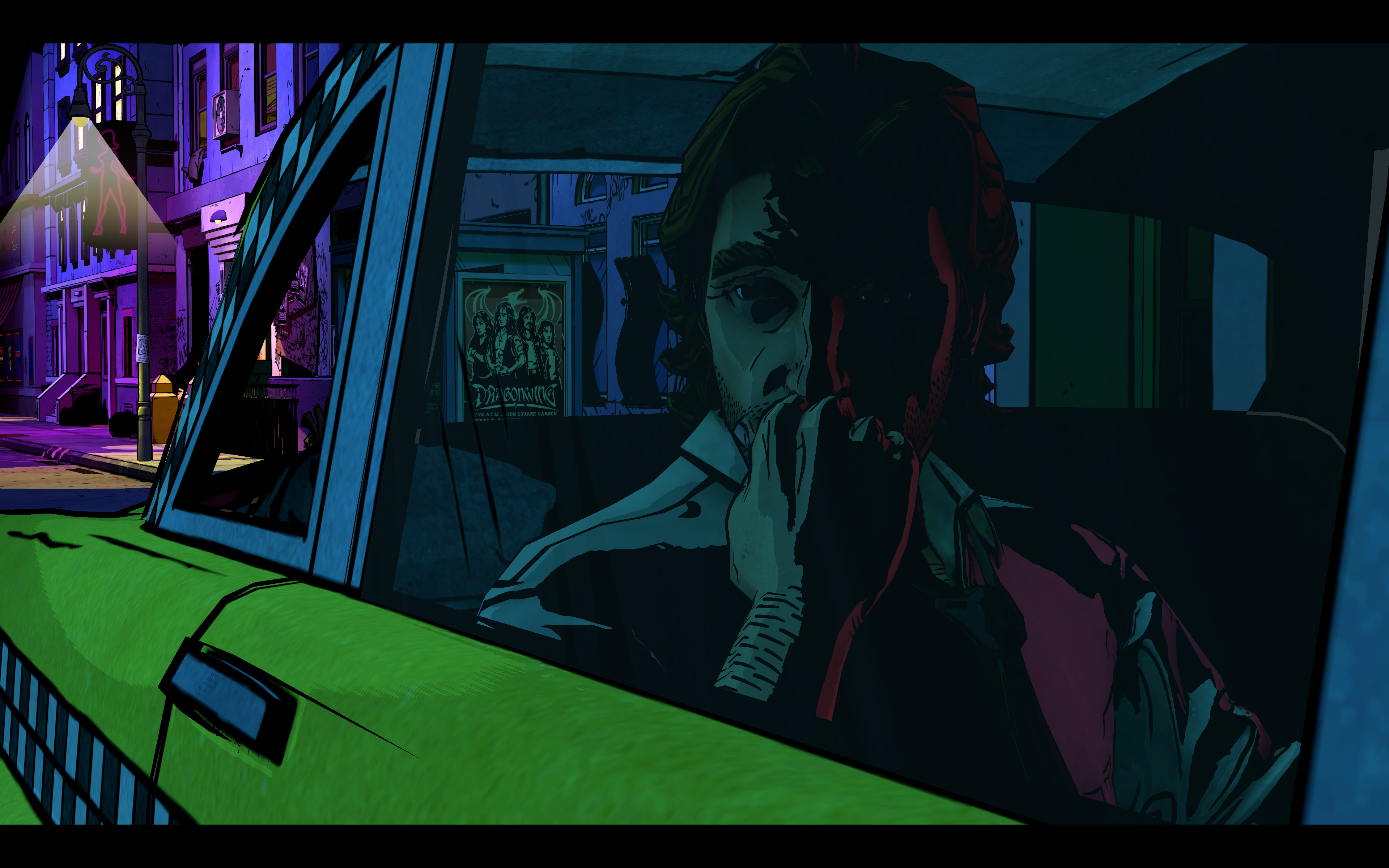
Pixel Boost is our weekly series devoted to the artistry of games, and the techniques required to run them at high resolutions.
Spoiler warning! The gallery grabs screens from most of the episodes, so if you've yet to play The Wolf Among Us we might recommend you, y'know, do that first.
I’m a big fan of the Fables comics series, and I’m not very into comics or talking animals (Homeward Bound is the one exception). They’re creepy. The idea of throwing fairy-tale characters into a grim, real world setting comes off as gimmicky—novel, sure, but not something I’d want to invest years of my life into. And while the series leans heavily on surprising the reader with referential reveals, folktales have persisted for a reason; there’s something universal in them, which is why if given proper development and nuance, the Big Bad Wolf can be a character to care about.
Hi-res how-to
With the Fables comic series at its end after 150 issues, I figured revisiting Telltale’s best-looking game would be a fit farewell to the fabled series. Hey-o!
Luckily, the resolution options were built directly into the game. Just head to the options and pump up the pixels. We ran GeDoSaTo to capture native screenshots, though. If you’d like to do the same, download the program, add “thewolfamongus” to the user whitelist, and assign a screenshot input in under “Edit Keybindings” by deleting the necessary hashes.
The Wolf Among Us is a prequel to the comic series, and carries a decidedly different neon noir tone with it. When a given scene is properly lit and populated, it looks almost directly out of a comic book in 4K. My praise isn’t exactly off-brand here. Neon and harsh lines have always been up my aesthetic alley, so when a scene splits the black with purples and pinks, I’m all in.
The downsampling nearly eliminates every hard edge, giving the colors a much more natural flow, like that of the printed page. The only real downside are the UI elements. QTE prompts look garish and artificial at such a high resolution, almost like clip art. Here's to hoping for a more natural solution in future Telltale games.
I’m not sure I’ll play a Telltale game in anything less than 4K from this point forward.
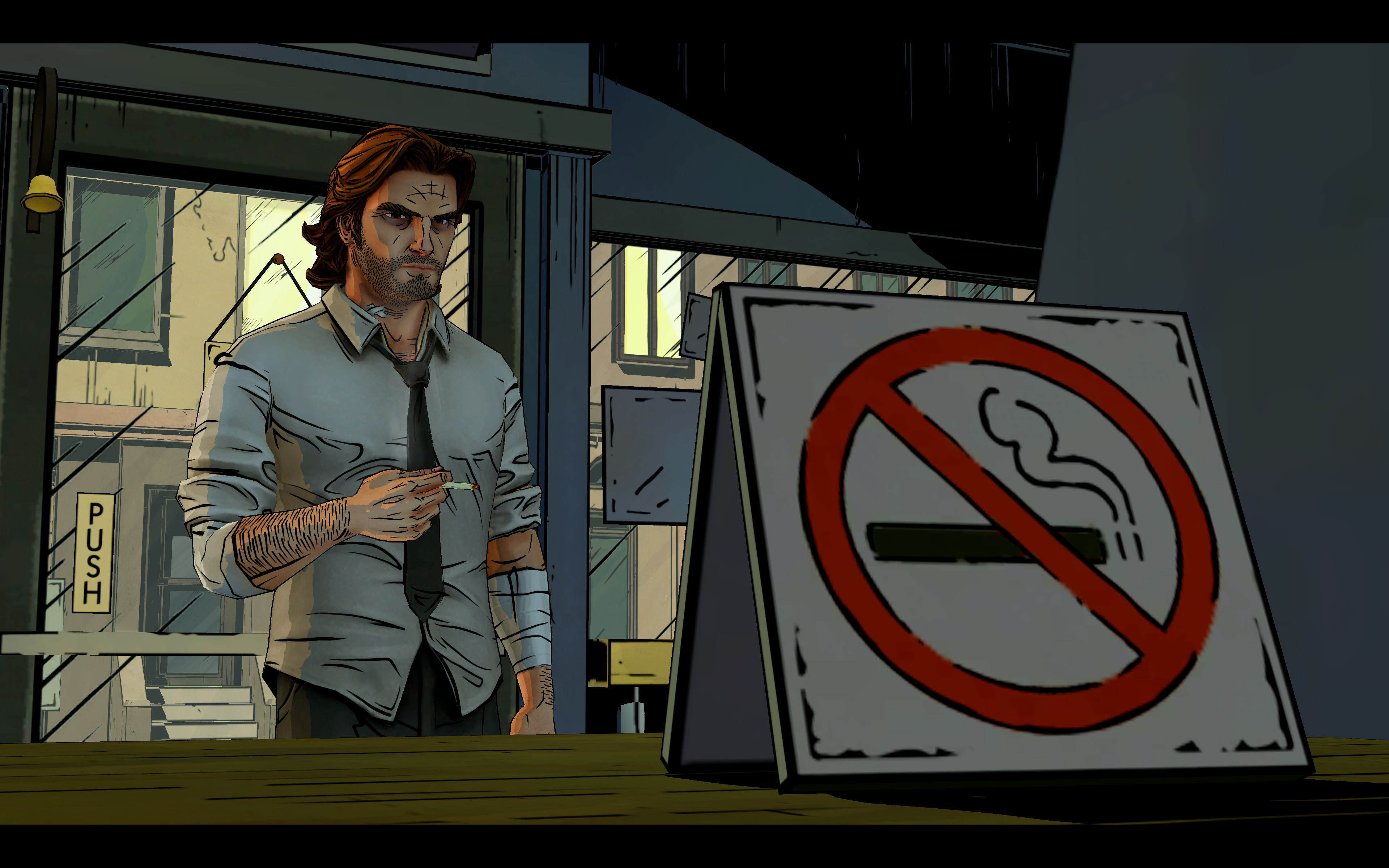
Pixel Boost is our weekly series devoted to the artistry of games, and the techniques required to run them at high resolutions.
Spoiler warning! The gallery grabs screens from most of the episodes, so if you've yet to play The Wolf Among Us we might recommend you, y'know, do that first.
I’m a big fan of the Fables comics series, and I’m not very into comics or talking animals (Homeward Bound is the one exception). They’re creepy. The idea of throwing fairy-tale characters into a grim, real world setting comes off as gimmicky—novel, sure, but not something I’d want to invest years of my life into. And while the series leans heavily on surprising the reader with referential reveals, folktales have persisted for a reason; there’s something universal in them, which is why if given proper development and nuance, the Big Bad Wolf can be a character to care about.
Hi-res how-to
With the Fables comic series at its end after 150 issues, I figured revisiting Telltale’s best-looking game would be a fit farewell to the fabled series. Hey-o!
Luckily, the resolution options were built directly into the game. Just head to the options and pump up the pixels. We ran GeDoSaTo to capture native screenshots, though. If you’d like to do the same, download the program, add “thewolfamongus” to the user whitelist, and assign a screenshot input in under “Edit Keybindings” by deleting the necessary hashes.
The Wolf Among Us is a prequel to the comic series, and carries a decidedly different neon noir tone with it. When a given scene is properly lit and populated, it looks almost directly out of a comic book in 4K. My praise isn’t exactly off-brand here. Neon and harsh lines have always been up my aesthetic alley, so when a scene splits the black with purples and pinks, I’m all in.
The downsampling nearly eliminates every hard edge, giving the colors a much more natural flow, like that of the printed page. The only real downside are the UI elements. QTE prompts look garish and artificial at such a high resolution, almost like clip art. Here's to hoping for a more natural solution in future Telltale games.
I’m not sure I’ll play a Telltale game in anything less than 4K from this point forward.
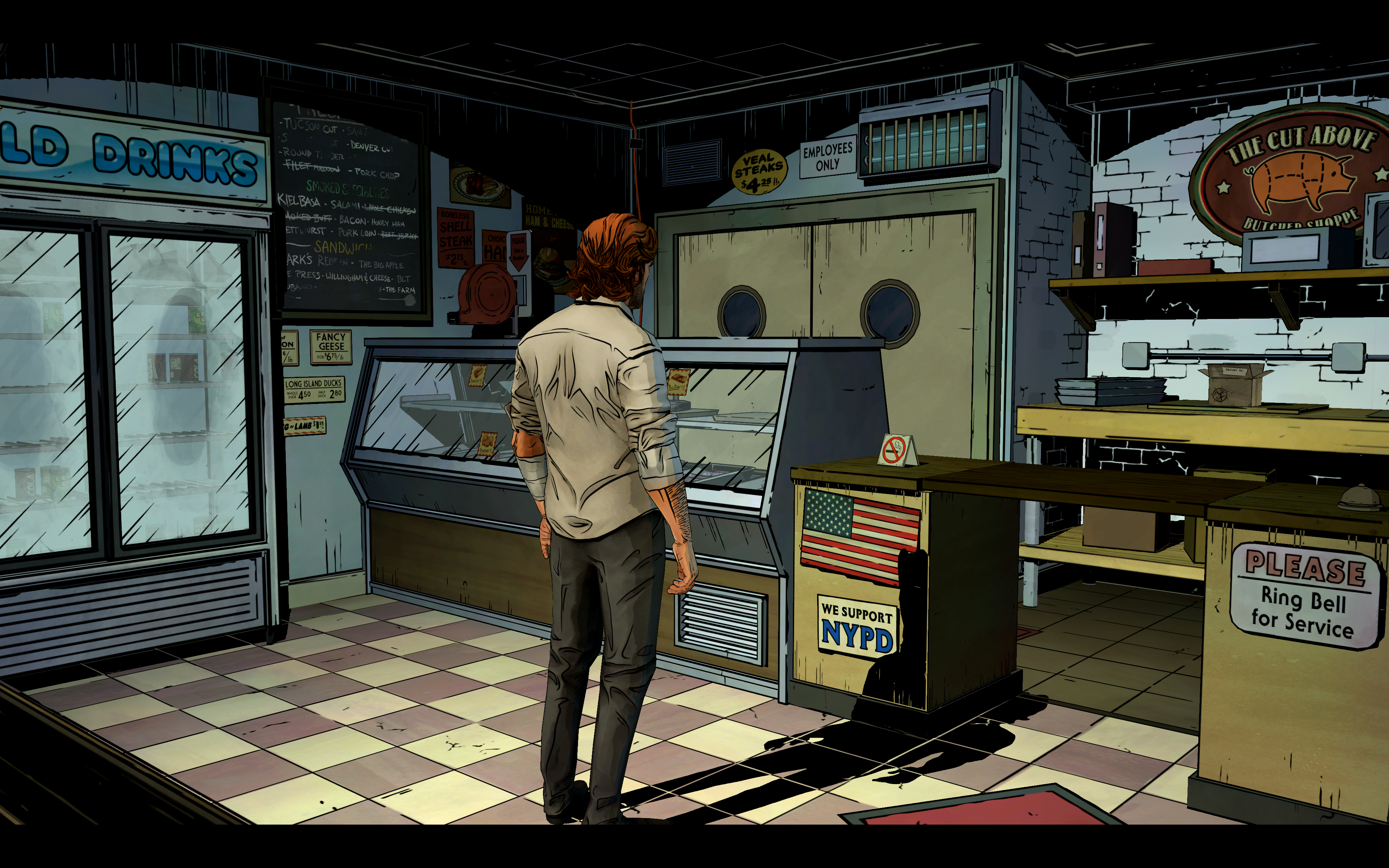
Pixel Boost is our weekly series devoted to the artistry of games, and the techniques required to run them at high resolutions.
Spoiler warning! The gallery grabs screens from most of the episodes, so if you've yet to play The Wolf Among Us we might recommend you, y'know, do that first.
I’m a big fan of the Fables comics series, and I’m not very into comics or talking animals (Homeward Bound is the one exception). They’re creepy. The idea of throwing fairy-tale characters into a grim, real world setting comes off as gimmicky—novel, sure, but not something I’d want to invest years of my life into. And while the series leans heavily on surprising the reader with referential reveals, folktales have persisted for a reason; there’s something universal in them, which is why if given proper development and nuance, the Big Bad Wolf can be a character to care about.
Hi-res how-to
With the Fables comic series at its end after 150 issues, I figured revisiting Telltale’s best-looking game would be a fit farewell to the fabled series. Hey-o!
Luckily, the resolution options were built directly into the game. Just head to the options and pump up the pixels. We ran GeDoSaTo to capture native screenshots, though. If you’d like to do the same, download the program, add “thewolfamongus” to the user whitelist, and assign a screenshot input in under “Edit Keybindings” by deleting the necessary hashes.
The Wolf Among Us is a prequel to the comic series, and carries a decidedly different neon noir tone with it. When a given scene is properly lit and populated, it looks almost directly out of a comic book in 4K. My praise isn’t exactly off-brand here. Neon and harsh lines have always been up my aesthetic alley, so when a scene splits the black with purples and pinks, I’m all in.
The downsampling nearly eliminates every hard edge, giving the colors a much more natural flow, like that of the printed page. The only real downside are the UI elements. QTE prompts look garish and artificial at such a high resolution, almost like clip art. Here's to hoping for a more natural solution in future Telltale games.
I’m not sure I’ll play a Telltale game in anything less than 4K from this point forward.
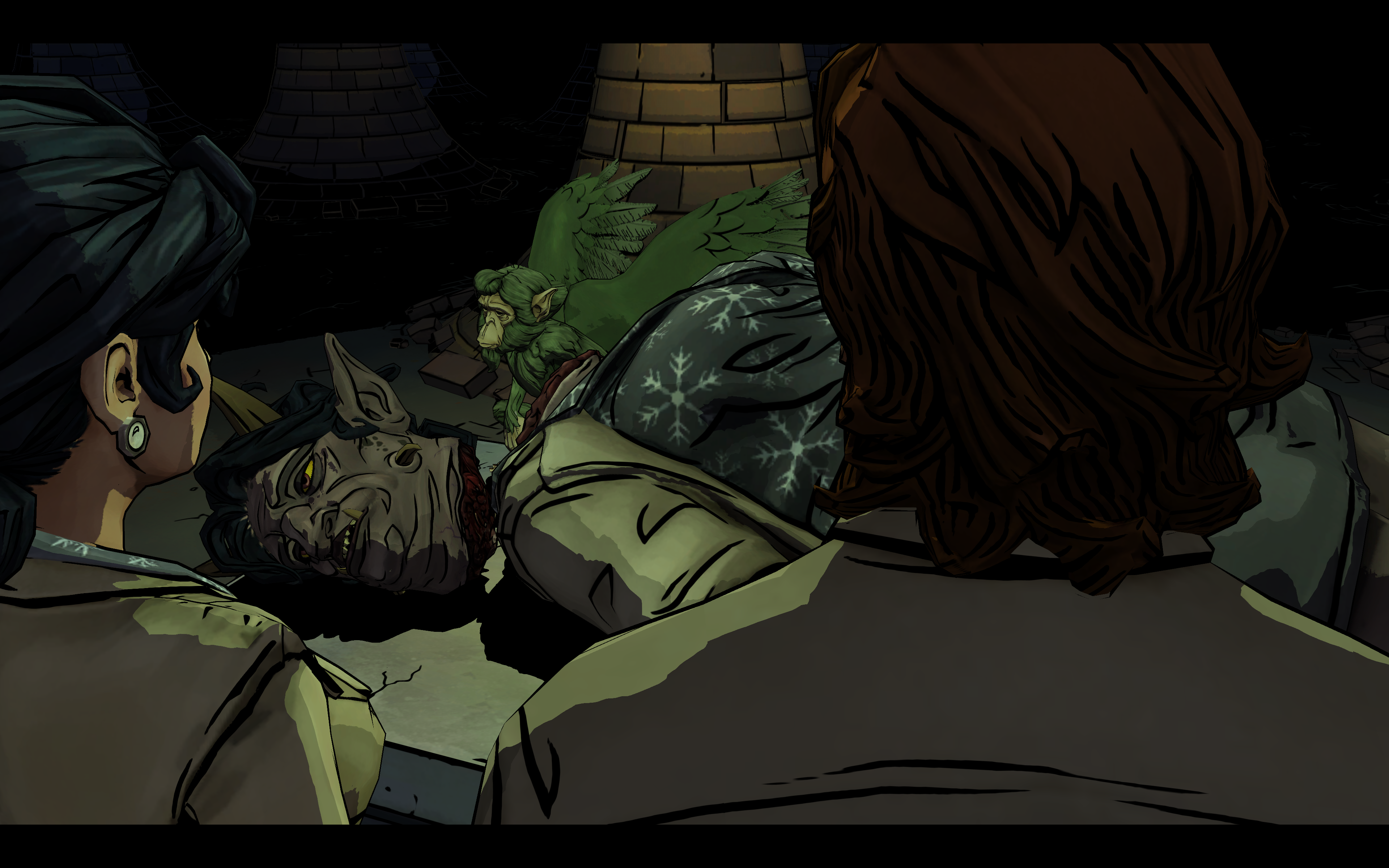
Pixel Boost is our weekly series devoted to the artistry of games, and the techniques required to run them at high resolutions.
Spoiler warning! The gallery grabs screens from most of the episodes, so if you've yet to play The Wolf Among Us we might recommend you, y'know, do that first.
I’m a big fan of the Fables comics series, and I’m not very into comics or talking animals (Homeward Bound is the one exception). They’re creepy. The idea of throwing fairy-tale characters into a grim, real world setting comes off as gimmicky—novel, sure, but not something I’d want to invest years of my life into. And while the series leans heavily on surprising the reader with referential reveals, folktales have persisted for a reason; there’s something universal in them, which is why if given proper development and nuance, the Big Bad Wolf can be a character to care about.
Hi-res how-to
With the Fables comic series at its end after 150 issues, I figured revisiting Telltale’s best-looking game would be a fit farewell to the fabled series. Hey-o!
Luckily, the resolution options were built directly into the game. Just head to the options and pump up the pixels. We ran GeDoSaTo to capture native screenshots, though. If you’d like to do the same, download the program, add “thewolfamongus” to the user whitelist, and assign a screenshot input in under “Edit Keybindings” by deleting the necessary hashes.
The Wolf Among Us is a prequel to the comic series, and carries a decidedly different neon noir tone with it. When a given scene is properly lit and populated, it looks almost directly out of a comic book in 4K. My praise isn’t exactly off-brand here. Neon and harsh lines have always been up my aesthetic alley, so when a scene splits the black with purples and pinks, I’m all in.
The downsampling nearly eliminates every hard edge, giving the colors a much more natural flow, like that of the printed page. The only real downside are the UI elements. QTE prompts look garish and artificial at such a high resolution, almost like clip art. Here's to hoping for a more natural solution in future Telltale games.
I’m not sure I’ll play a Telltale game in anything less than 4K from this point forward.
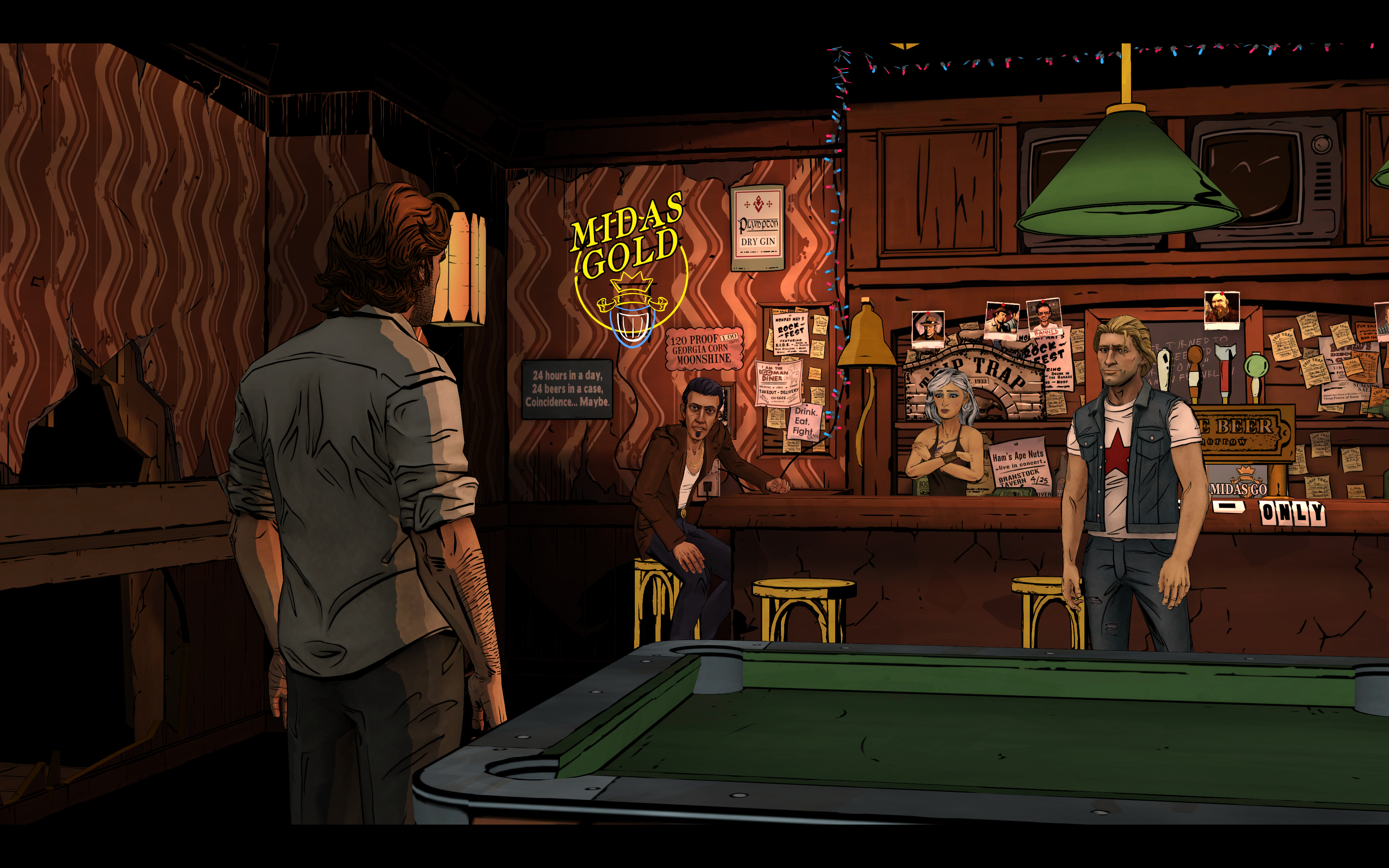
Pixel Boost is our weekly series devoted to the artistry of games, and the techniques required to run them at high resolutions.
Spoiler warning! The gallery grabs screens from most of the episodes, so if you've yet to play The Wolf Among Us we might recommend you, y'know, do that first.
I’m a big fan of the Fables comics series, and I’m not very into comics or talking animals (Homeward Bound is the one exception). They’re creepy. The idea of throwing fairy-tale characters into a grim, real world setting comes off as gimmicky—novel, sure, but not something I’d want to invest years of my life into. And while the series leans heavily on surprising the reader with referential reveals, folktales have persisted for a reason; there’s something universal in them, which is why if given proper development and nuance, the Big Bad Wolf can be a character to care about.
Hi-res how-to
With the Fables comic series at its end after 150 issues, I figured revisiting Telltale’s best-looking game would be a fit farewell to the fabled series. Hey-o!
Luckily, the resolution options were built directly into the game. Just head to the options and pump up the pixels. We ran GeDoSaTo to capture native screenshots, though. If you’d like to do the same, download the program, add “thewolfamongus” to the user whitelist, and assign a screenshot input in under “Edit Keybindings” by deleting the necessary hashes.
The Wolf Among Us is a prequel to the comic series, and carries a decidedly different neon noir tone with it. When a given scene is properly lit and populated, it looks almost directly out of a comic book in 4K. My praise isn’t exactly off-brand here. Neon and harsh lines have always been up my aesthetic alley, so when a scene splits the black with purples and pinks, I’m all in.
The downsampling nearly eliminates every hard edge, giving the colors a much more natural flow, like that of the printed page. The only real downside are the UI elements. QTE prompts look garish and artificial at such a high resolution, almost like clip art. Here's to hoping for a more natural solution in future Telltale games.
I’m not sure I’ll play a Telltale game in anything less than 4K from this point forward.
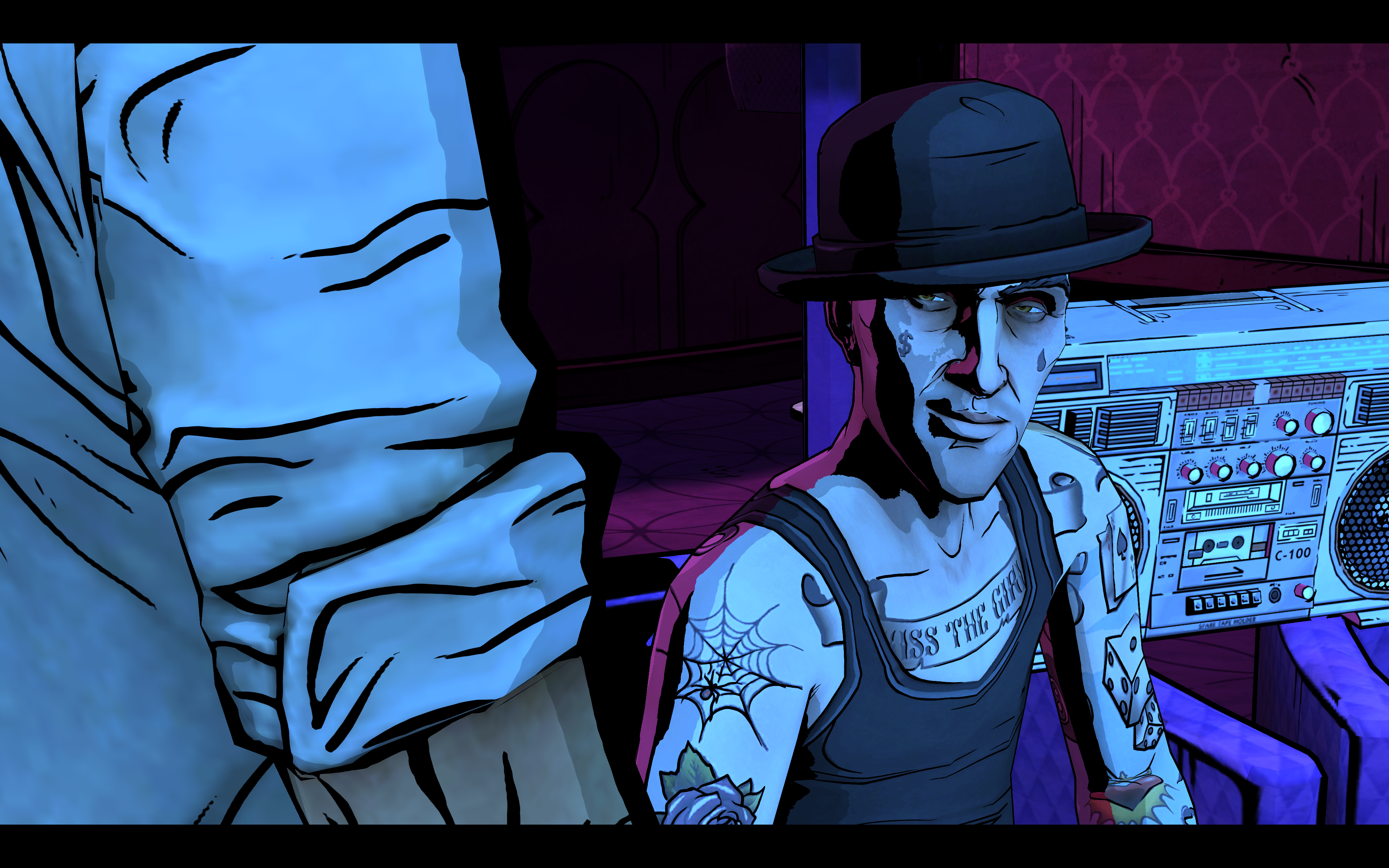
Pixel Boost is our weekly series devoted to the artistry of games, and the techniques required to run them at high resolutions.
Spoiler warning! The gallery grabs screens from most of the episodes, so if you've yet to play The Wolf Among Us we might recommend you, y'know, do that first.
I’m a big fan of the Fables comics series, and I’m not very into comics or talking animals (Homeward Bound is the one exception). They’re creepy. The idea of throwing fairy-tale characters into a grim, real world setting comes off as gimmicky—novel, sure, but not something I’d want to invest years of my life into. And while the series leans heavily on surprising the reader with referential reveals, folktales have persisted for a reason; there’s something universal in them, which is why if given proper development and nuance, the Big Bad Wolf can be a character to care about.
Hi-res how-to
With the Fables comic series at its end after 150 issues, I figured revisiting Telltale’s best-looking game would be a fit farewell to the fabled series. Hey-o!
Luckily, the resolution options were built directly into the game. Just head to the options and pump up the pixels. We ran GeDoSaTo to capture native screenshots, though. If you’d like to do the same, download the program, add “thewolfamongus” to the user whitelist, and assign a screenshot input in under “Edit Keybindings” by deleting the necessary hashes.
The Wolf Among Us is a prequel to the comic series, and carries a decidedly different neon noir tone with it. When a given scene is properly lit and populated, it looks almost directly out of a comic book in 4K. My praise isn’t exactly off-brand here. Neon and harsh lines have always been up my aesthetic alley, so when a scene splits the black with purples and pinks, I’m all in.
The downsampling nearly eliminates every hard edge, giving the colors a much more natural flow, like that of the printed page. The only real downside are the UI elements. QTE prompts look garish and artificial at such a high resolution, almost like clip art. Here's to hoping for a more natural solution in future Telltale games.
I’m not sure I’ll play a Telltale game in anything less than 4K from this point forward.
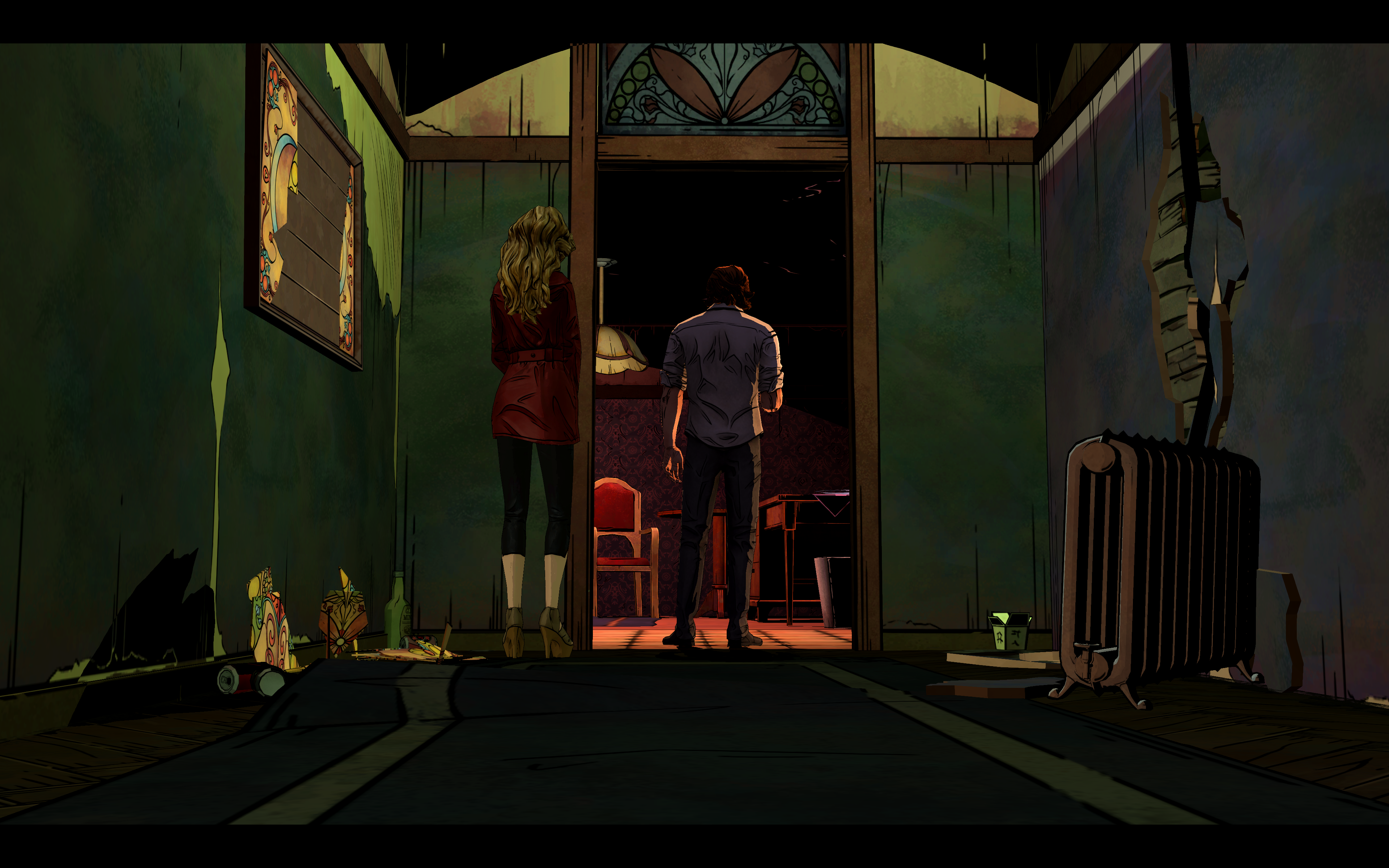
Pixel Boost is our weekly series devoted to the artistry of games, and the techniques required to run them at high resolutions.
Spoiler warning! The gallery grabs screens from most of the episodes, so if you've yet to play The Wolf Among Us we might recommend you, y'know, do that first.
I’m a big fan of the Fables comics series, and I’m not very into comics or talking animals (Homeward Bound is the one exception). They’re creepy. The idea of throwing fairy-tale characters into a grim, real world setting comes off as gimmicky—novel, sure, but not something I’d want to invest years of my life into. And while the series leans heavily on surprising the reader with referential reveals, folktales have persisted for a reason; there’s something universal in them, which is why if given proper development and nuance, the Big Bad Wolf can be a character to care about.
Hi-res how-to
With the Fables comic series at its end after 150 issues, I figured revisiting Telltale’s best-looking game would be a fit farewell to the fabled series. Hey-o!
Luckily, the resolution options were built directly into the game. Just head to the options and pump up the pixels. We ran GeDoSaTo to capture native screenshots, though. If you’d like to do the same, download the program, add “thewolfamongus” to the user whitelist, and assign a screenshot input in under “Edit Keybindings” by deleting the necessary hashes.
The Wolf Among Us is a prequel to the comic series, and carries a decidedly different neon noir tone with it. When a given scene is properly lit and populated, it looks almost directly out of a comic book in 4K. My praise isn’t exactly off-brand here. Neon and harsh lines have always been up my aesthetic alley, so when a scene splits the black with purples and pinks, I’m all in.
The downsampling nearly eliminates every hard edge, giving the colors a much more natural flow, like that of the printed page. The only real downside are the UI elements. QTE prompts look garish and artificial at such a high resolution, almost like clip art. Here's to hoping for a more natural solution in future Telltale games.
I’m not sure I’ll play a Telltale game in anything less than 4K from this point forward.
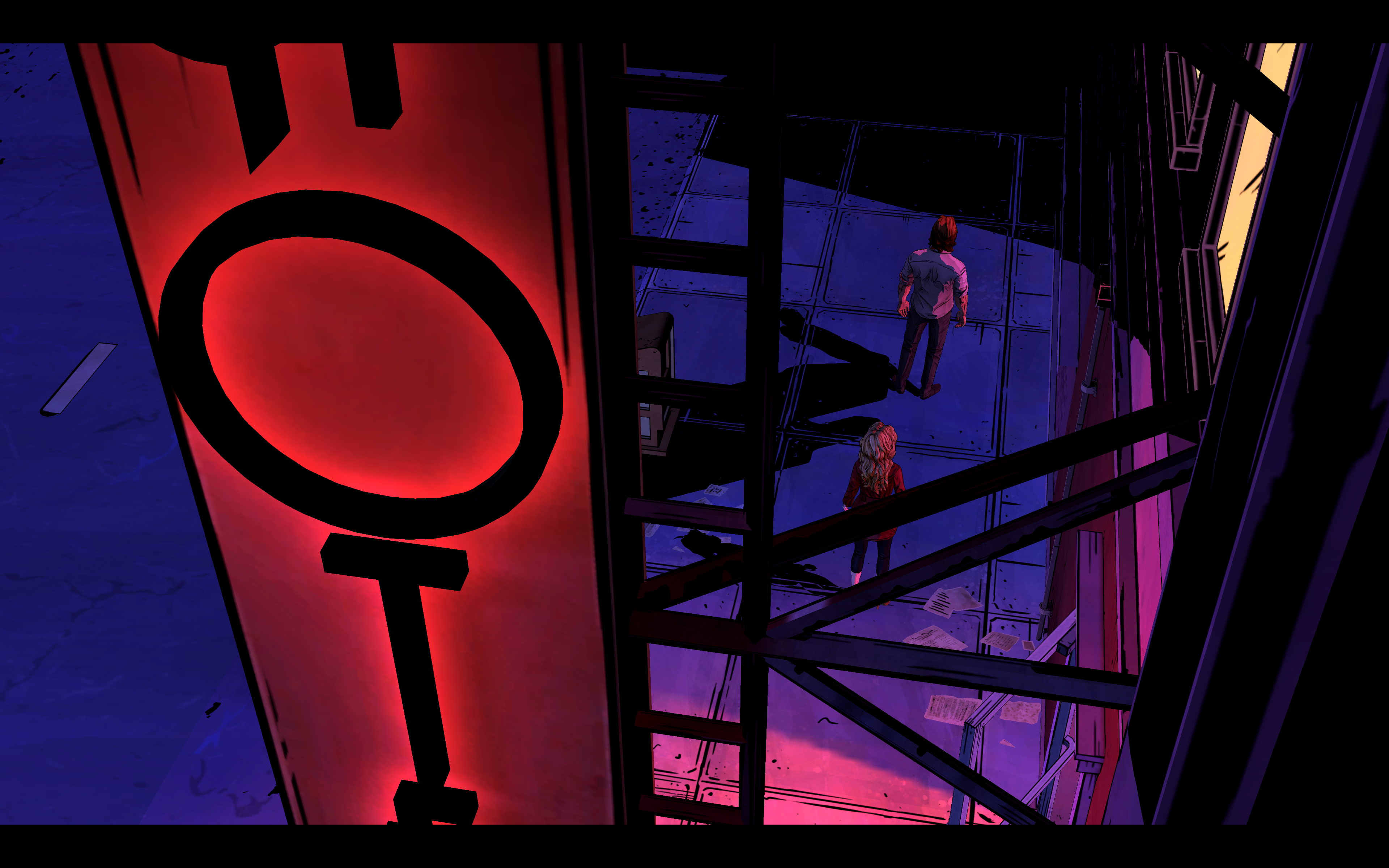
Pixel Boost is our weekly series devoted to the artistry of games, and the techniques required to run them at high resolutions.
Spoiler warning! The gallery grabs screens from most of the episodes, so if you've yet to play The Wolf Among Us we might recommend you, y'know, do that first.
I’m a big fan of the Fables comics series, and I’m not very into comics or talking animals (Homeward Bound is the one exception). They’re creepy. The idea of throwing fairy-tale characters into a grim, real world setting comes off as gimmicky—novel, sure, but not something I’d want to invest years of my life into. And while the series leans heavily on surprising the reader with referential reveals, folktales have persisted for a reason; there’s something universal in them, which is why if given proper development and nuance, the Big Bad Wolf can be a character to care about.
Hi-res how-to
With the Fables comic series at its end after 150 issues, I figured revisiting Telltale’s best-looking game would be a fit farewell to the fabled series. Hey-o!
Luckily, the resolution options were built directly into the game. Just head to the options and pump up the pixels. We ran GeDoSaTo to capture native screenshots, though. If you’d like to do the same, download the program, add “thewolfamongus” to the user whitelist, and assign a screenshot input in under “Edit Keybindings” by deleting the necessary hashes.
The Wolf Among Us is a prequel to the comic series, and carries a decidedly different neon noir tone with it. When a given scene is properly lit and populated, it looks almost directly out of a comic book in 4K. My praise isn’t exactly off-brand here. Neon and harsh lines have always been up my aesthetic alley, so when a scene splits the black with purples and pinks, I’m all in.
The downsampling nearly eliminates every hard edge, giving the colors a much more natural flow, like that of the printed page. The only real downside are the UI elements. QTE prompts look garish and artificial at such a high resolution, almost like clip art. Here's to hoping for a more natural solution in future Telltale games.
I’m not sure I’ll play a Telltale game in anything less than 4K from this point forward.
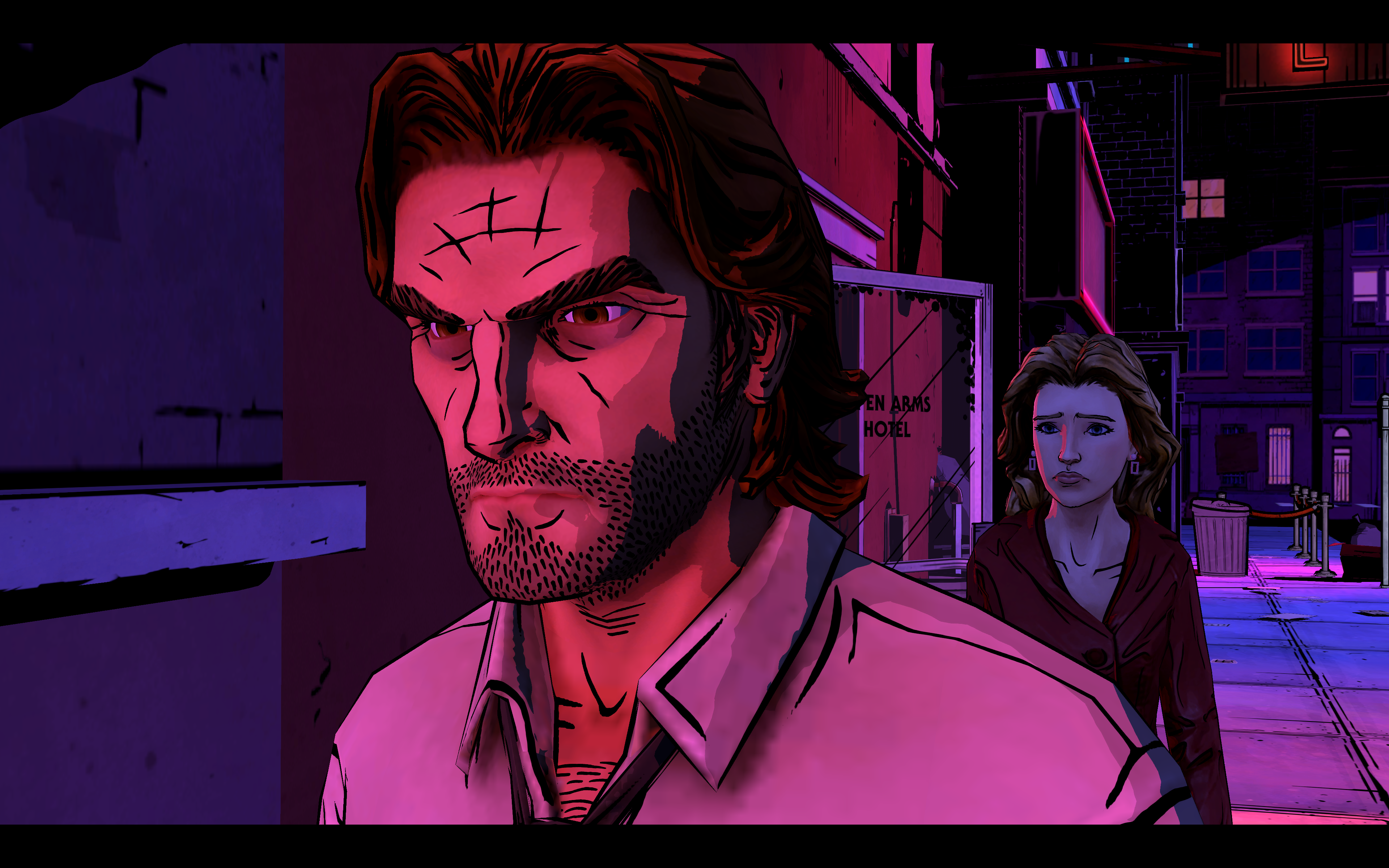
Pixel Boost is our weekly series devoted to the artistry of games, and the techniques required to run them at high resolutions.
Spoiler warning! The gallery grabs screens from most of the episodes, so if you've yet to play The Wolf Among Us we might recommend you, y'know, do that first.
I’m a big fan of the Fables comics series, and I’m not very into comics or talking animals (Homeward Bound is the one exception). They’re creepy. The idea of throwing fairy-tale characters into a grim, real world setting comes off as gimmicky—novel, sure, but not something I’d want to invest years of my life into. And while the series leans heavily on surprising the reader with referential reveals, folktales have persisted for a reason; there’s something universal in them, which is why if given proper development and nuance, the Big Bad Wolf can be a character to care about.
Hi-res how-to
With the Fables comic series at its end after 150 issues, I figured revisiting Telltale’s best-looking game would be a fit farewell to the fabled series. Hey-o!
Luckily, the resolution options were built directly into the game. Just head to the options and pump up the pixels. We ran GeDoSaTo to capture native screenshots, though. If you’d like to do the same, download the program, add “thewolfamongus” to the user whitelist, and assign a screenshot input in under “Edit Keybindings” by deleting the necessary hashes.
The Wolf Among Us is a prequel to the comic series, and carries a decidedly different neon noir tone with it. When a given scene is properly lit and populated, it looks almost directly out of a comic book in 4K. My praise isn’t exactly off-brand here. Neon and harsh lines have always been up my aesthetic alley, so when a scene splits the black with purples and pinks, I’m all in.
The downsampling nearly eliminates every hard edge, giving the colors a much more natural flow, like that of the printed page. The only real downside are the UI elements. QTE prompts look garish and artificial at such a high resolution, almost like clip art. Here's to hoping for a more natural solution in future Telltale games.
I’m not sure I’ll play a Telltale game in anything less than 4K from this point forward.
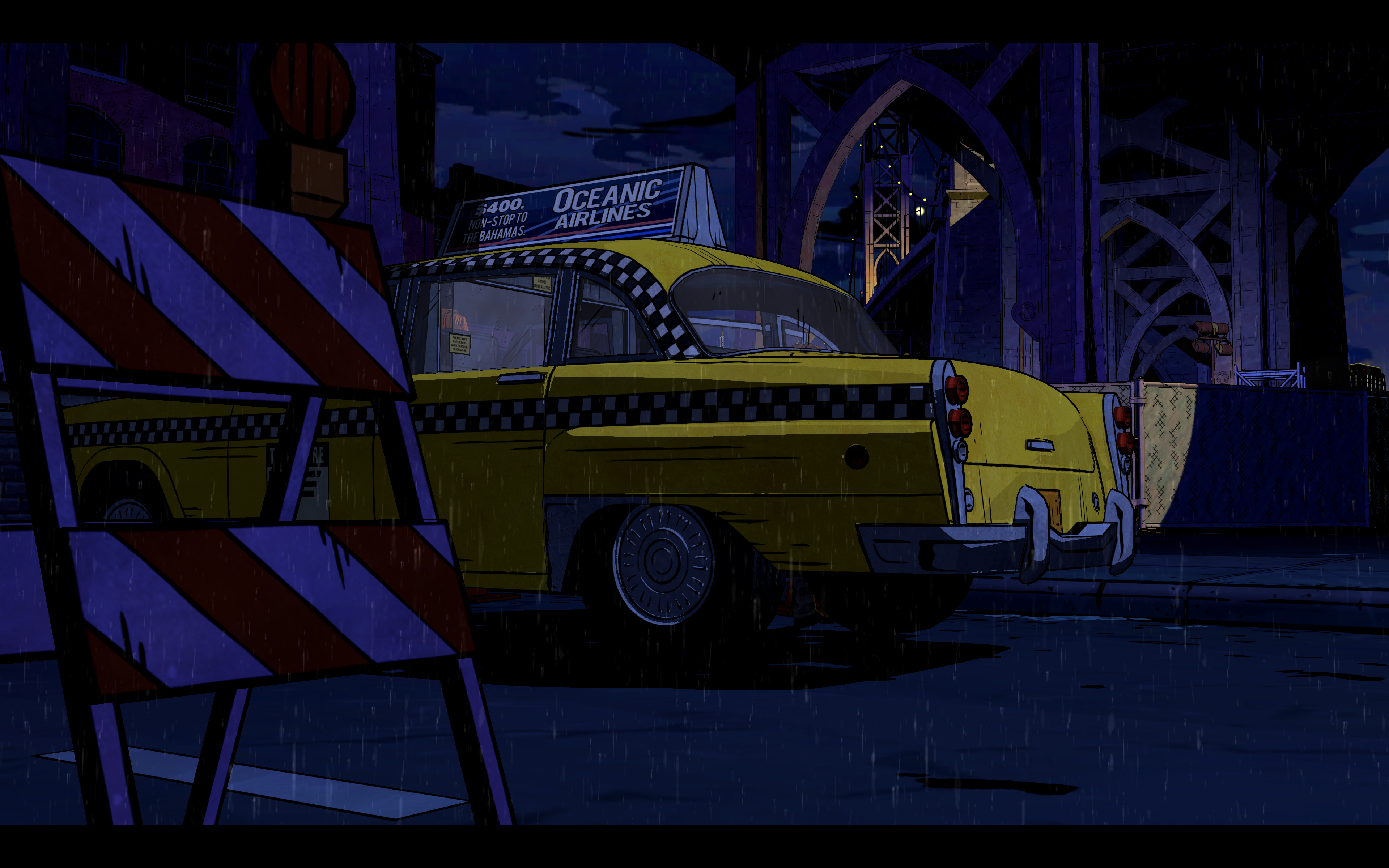
Pixel Boost is our weekly series devoted to the artistry of games, and the techniques required to run them at high resolutions.
Spoiler warning! The gallery grabs screens from most of the episodes, so if you've yet to play The Wolf Among Us we might recommend you, y'know, do that first.
I’m a big fan of the Fables comics series, and I’m not very into comics or talking animals (Homeward Bound is the one exception). They’re creepy. The idea of throwing fairy-tale characters into a grim, real world setting comes off as gimmicky—novel, sure, but not something I’d want to invest years of my life into. And while the series leans heavily on surprising the reader with referential reveals, folktales have persisted for a reason; there’s something universal in them, which is why if given proper development and nuance, the Big Bad Wolf can be a character to care about.
Hi-res how-to
With the Fables comic series at its end after 150 issues, I figured revisiting Telltale’s best-looking game would be a fit farewell to the fabled series. Hey-o!
Luckily, the resolution options were built directly into the game. Just head to the options and pump up the pixels. We ran GeDoSaTo to capture native screenshots, though. If you’d like to do the same, download the program, add “thewolfamongus” to the user whitelist, and assign a screenshot input in under “Edit Keybindings” by deleting the necessary hashes.
The Wolf Among Us is a prequel to the comic series, and carries a decidedly different neon noir tone with it. When a given scene is properly lit and populated, it looks almost directly out of a comic book in 4K. My praise isn’t exactly off-brand here. Neon and harsh lines have always been up my aesthetic alley, so when a scene splits the black with purples and pinks, I’m all in.
The downsampling nearly eliminates every hard edge, giving the colors a much more natural flow, like that of the printed page. The only real downside are the UI elements. QTE prompts look garish and artificial at such a high resolution, almost like clip art. Here's to hoping for a more natural solution in future Telltale games.
I’m not sure I’ll play a Telltale game in anything less than 4K from this point forward.
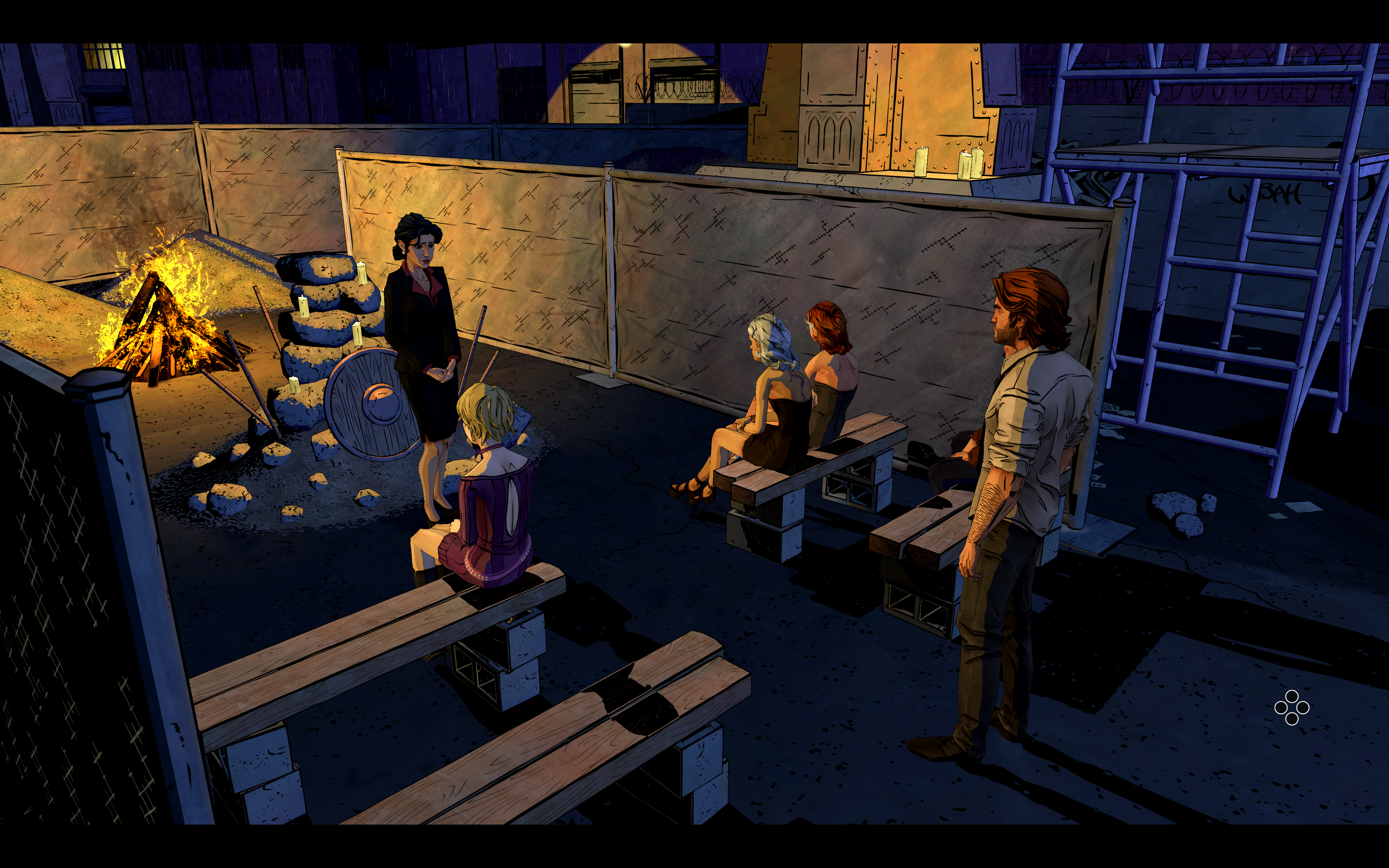
Pixel Boost is our weekly series devoted to the artistry of games, and the techniques required to run them at high resolutions.
Spoiler warning! The gallery grabs screens from most of the episodes, so if you've yet to play The Wolf Among Us we might recommend you, y'know, do that first.
I’m a big fan of the Fables comics series, and I’m not very into comics or talking animals (Homeward Bound is the one exception). They’re creepy. The idea of throwing fairy-tale characters into a grim, real world setting comes off as gimmicky—novel, sure, but not something I’d want to invest years of my life into. And while the series leans heavily on surprising the reader with referential reveals, folktales have persisted for a reason; there’s something universal in them, which is why if given proper development and nuance, the Big Bad Wolf can be a character to care about.
Hi-res how-to
With the Fables comic series at its end after 150 issues, I figured revisiting Telltale’s best-looking game would be a fit farewell to the fabled series. Hey-o!
Luckily, the resolution options were built directly into the game. Just head to the options and pump up the pixels. We ran GeDoSaTo to capture native screenshots, though. If you’d like to do the same, download the program, add “thewolfamongus” to the user whitelist, and assign a screenshot input in under “Edit Keybindings” by deleting the necessary hashes.
The Wolf Among Us is a prequel to the comic series, and carries a decidedly different neon noir tone with it. When a given scene is properly lit and populated, it looks almost directly out of a comic book in 4K. My praise isn’t exactly off-brand here. Neon and harsh lines have always been up my aesthetic alley, so when a scene splits the black with purples and pinks, I’m all in.
The downsampling nearly eliminates every hard edge, giving the colors a much more natural flow, like that of the printed page. The only real downside are the UI elements. QTE prompts look garish and artificial at such a high resolution, almost like clip art. Here's to hoping for a more natural solution in future Telltale games.
I’m not sure I’ll play a Telltale game in anything less than 4K from this point forward.
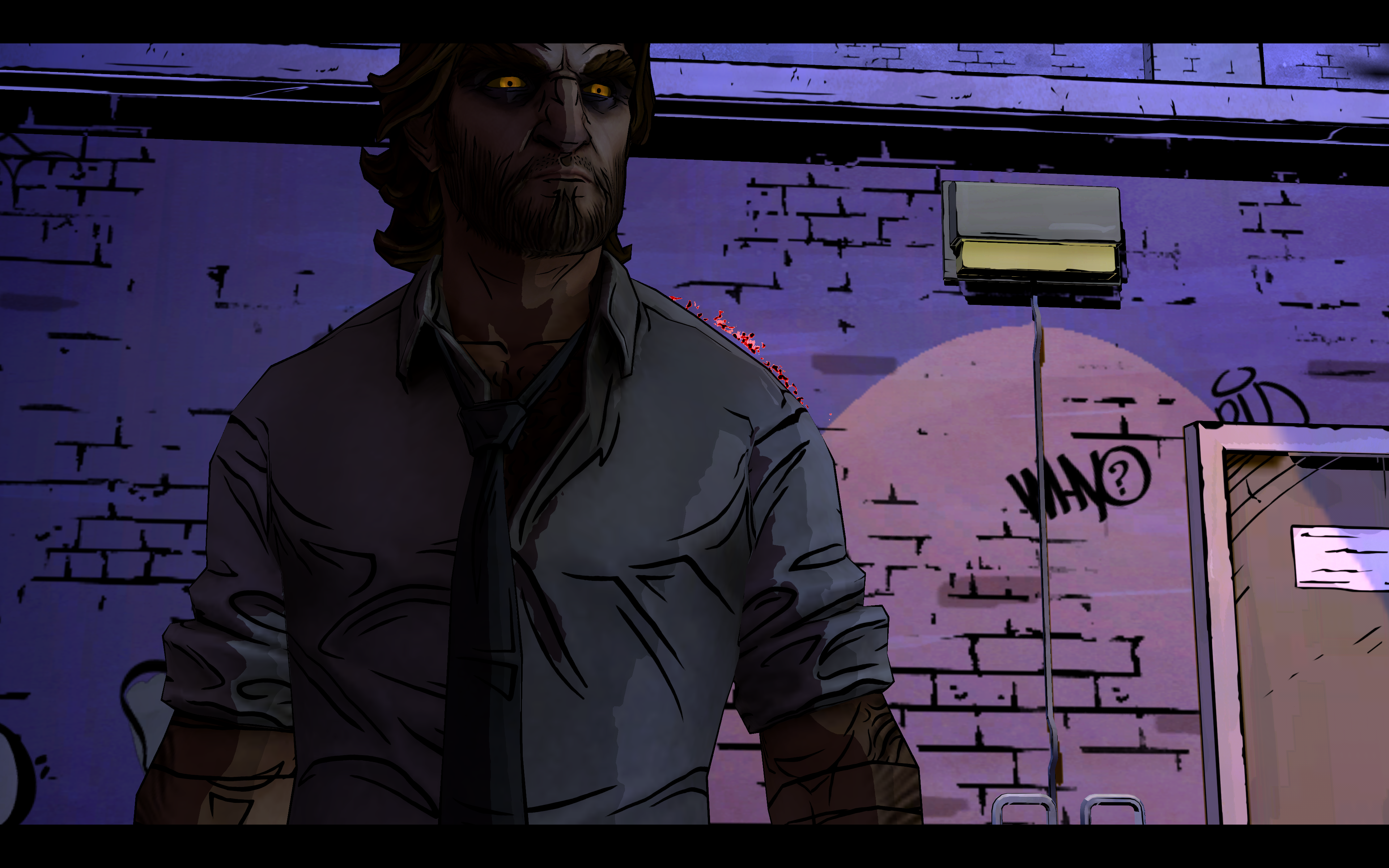
Pixel Boost is our weekly series devoted to the artistry of games, and the techniques required to run them at high resolutions.
Spoiler warning! The gallery grabs screens from most of the episodes, so if you've yet to play The Wolf Among Us we might recommend you, y'know, do that first.
I’m a big fan of the Fables comics series, and I’m not very into comics or talking animals (Homeward Bound is the one exception). They’re creepy. The idea of throwing fairy-tale characters into a grim, real world setting comes off as gimmicky—novel, sure, but not something I’d want to invest years of my life into. And while the series leans heavily on surprising the reader with referential reveals, folktales have persisted for a reason; there’s something universal in them, which is why if given proper development and nuance, the Big Bad Wolf can be a character to care about.
Hi-res how-to
With the Fables comic series at its end after 150 issues, I figured revisiting Telltale’s best-looking game would be a fit farewell to the fabled series. Hey-o!
Luckily, the resolution options were built directly into the game. Just head to the options and pump up the pixels. We ran GeDoSaTo to capture native screenshots, though. If you’d like to do the same, download the program, add “thewolfamongus” to the user whitelist, and assign a screenshot input in under “Edit Keybindings” by deleting the necessary hashes.
The Wolf Among Us is a prequel to the comic series, and carries a decidedly different neon noir tone with it. When a given scene is properly lit and populated, it looks almost directly out of a comic book in 4K. My praise isn’t exactly off-brand here. Neon and harsh lines have always been up my aesthetic alley, so when a scene splits the black with purples and pinks, I’m all in.
The downsampling nearly eliminates every hard edge, giving the colors a much more natural flow, like that of the printed page. The only real downside are the UI elements. QTE prompts look garish and artificial at such a high resolution, almost like clip art. Here's to hoping for a more natural solution in future Telltale games.
I’m not sure I’ll play a Telltale game in anything less than 4K from this point forward.
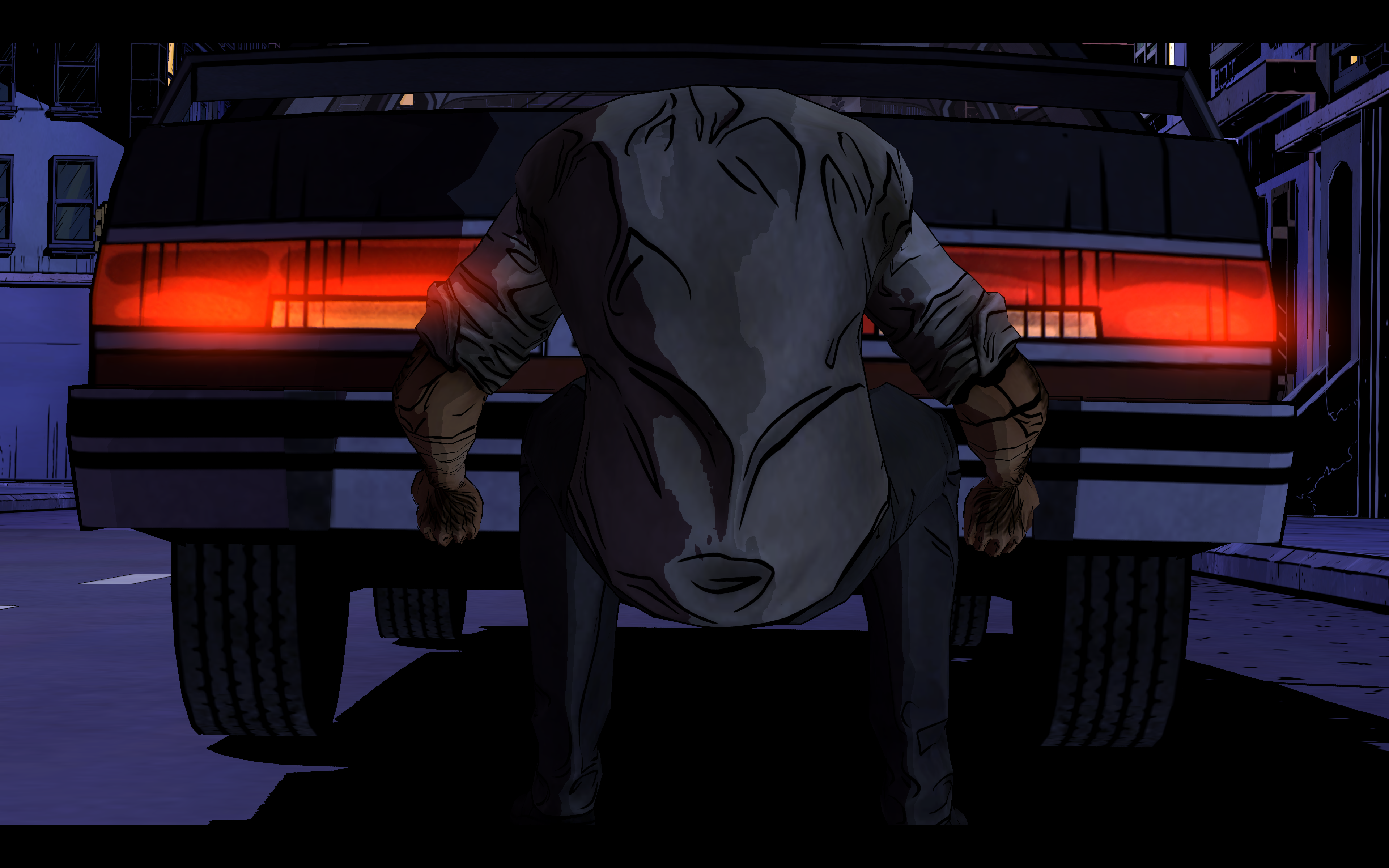
Pixel Boost is our weekly series devoted to the artistry of games, and the techniques required to run them at high resolutions.
Spoiler warning! The gallery grabs screens from most of the episodes, so if you've yet to play The Wolf Among Us we might recommend you, y'know, do that first.
I’m a big fan of the Fables comics series, and I’m not very into comics or talking animals (Homeward Bound is the one exception). They’re creepy. The idea of throwing fairy-tale characters into a grim, real world setting comes off as gimmicky—novel, sure, but not something I’d want to invest years of my life into. And while the series leans heavily on surprising the reader with referential reveals, folktales have persisted for a reason; there’s something universal in them, which is why if given proper development and nuance, the Big Bad Wolf can be a character to care about.
Hi-res how-to
With the Fables comic series at its end after 150 issues, I figured revisiting Telltale’s best-looking game would be a fit farewell to the fabled series. Hey-o!
Luckily, the resolution options were built directly into the game. Just head to the options and pump up the pixels. We ran GeDoSaTo to capture native screenshots, though. If you’d like to do the same, download the program, add “thewolfamongus” to the user whitelist, and assign a screenshot input in under “Edit Keybindings” by deleting the necessary hashes.
The Wolf Among Us is a prequel to the comic series, and carries a decidedly different neon noir tone with it. When a given scene is properly lit and populated, it looks almost directly out of a comic book in 4K. My praise isn’t exactly off-brand here. Neon and harsh lines have always been up my aesthetic alley, so when a scene splits the black with purples and pinks, I’m all in.
The downsampling nearly eliminates every hard edge, giving the colors a much more natural flow, like that of the printed page. The only real downside are the UI elements. QTE prompts look garish and artificial at such a high resolution, almost like clip art. Here's to hoping for a more natural solution in future Telltale games.
I’m not sure I’ll play a Telltale game in anything less than 4K from this point forward.
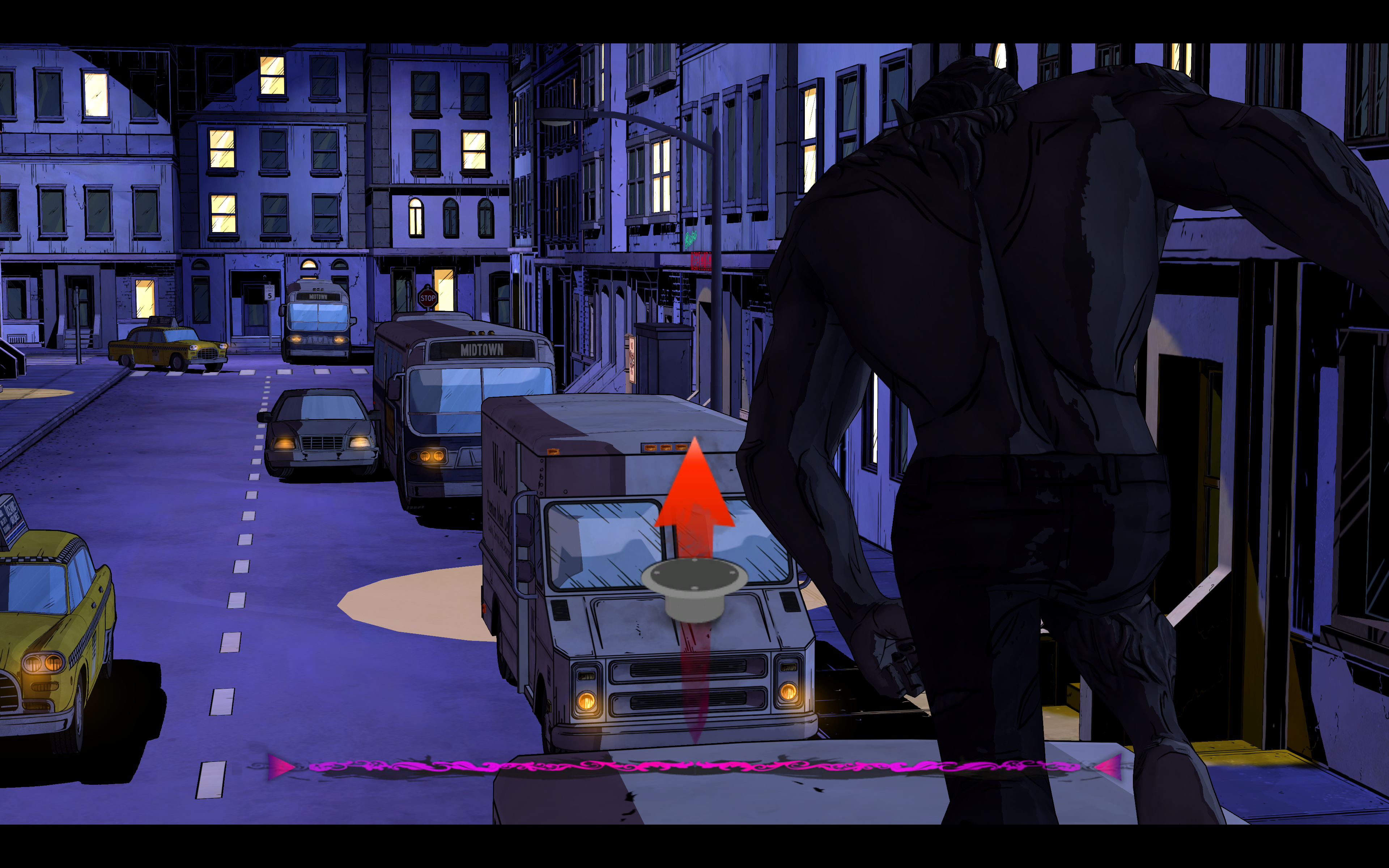
Pixel Boost is our weekly series devoted to the artistry of games, and the techniques required to run them at high resolutions.
Spoiler warning! The gallery grabs screens from most of the episodes, so if you've yet to play The Wolf Among Us we might recommend you, y'know, do that first.
I’m a big fan of the Fables comics series, and I’m not very into comics or talking animals (Homeward Bound is the one exception). They’re creepy. The idea of throwing fairy-tale characters into a grim, real world setting comes off as gimmicky—novel, sure, but not something I’d want to invest years of my life into. And while the series leans heavily on surprising the reader with referential reveals, folktales have persisted for a reason; there’s something universal in them, which is why if given proper development and nuance, the Big Bad Wolf can be a character to care about.
Hi-res how-to
With the Fables comic series at its end after 150 issues, I figured revisiting Telltale’s best-looking game would be a fit farewell to the fabled series. Hey-o!
Luckily, the resolution options were built directly into the game. Just head to the options and pump up the pixels. We ran GeDoSaTo to capture native screenshots, though. If you’d like to do the same, download the program, add “thewolfamongus” to the user whitelist, and assign a screenshot input in under “Edit Keybindings” by deleting the necessary hashes.
The Wolf Among Us is a prequel to the comic series, and carries a decidedly different neon noir tone with it. When a given scene is properly lit and populated, it looks almost directly out of a comic book in 4K. My praise isn’t exactly off-brand here. Neon and harsh lines have always been up my aesthetic alley, so when a scene splits the black with purples and pinks, I’m all in.
The downsampling nearly eliminates every hard edge, giving the colors a much more natural flow, like that of the printed page. The only real downside are the UI elements. QTE prompts look garish and artificial at such a high resolution, almost like clip art. Here's to hoping for a more natural solution in future Telltale games.
I’m not sure I’ll play a Telltale game in anything less than 4K from this point forward.
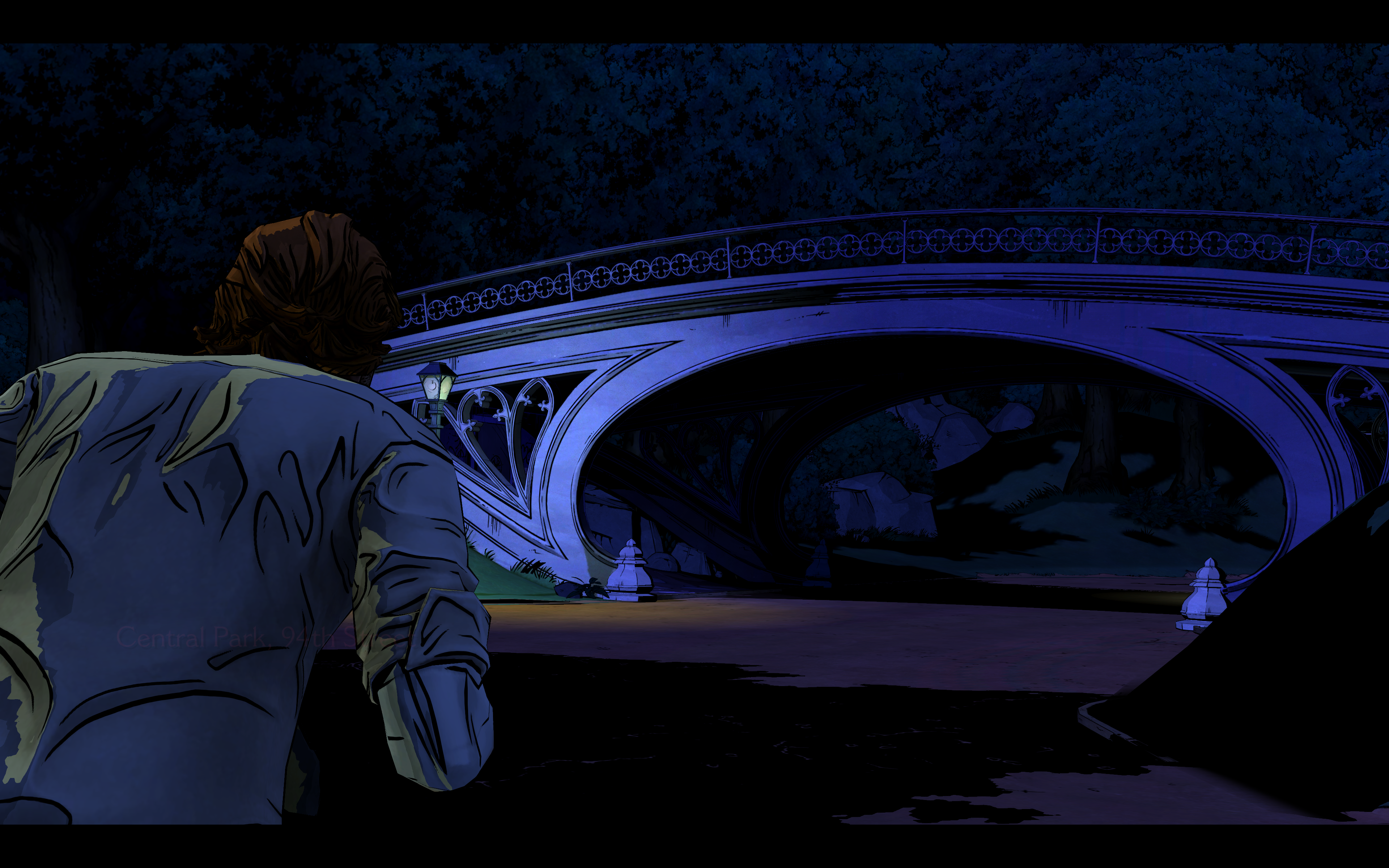
Pixel Boost is our weekly series devoted to the artistry of games, and the techniques required to run them at high resolutions.
Spoiler warning! The gallery grabs screens from most of the episodes, so if you've yet to play The Wolf Among Us we might recommend you, y'know, do that first.
I’m a big fan of the Fables comics series, and I’m not very into comics or talking animals (Homeward Bound is the one exception). They’re creepy. The idea of throwing fairy-tale characters into a grim, real world setting comes off as gimmicky—novel, sure, but not something I’d want to invest years of my life into. And while the series leans heavily on surprising the reader with referential reveals, folktales have persisted for a reason; there’s something universal in them, which is why if given proper development and nuance, the Big Bad Wolf can be a character to care about.
Hi-res how-to
With the Fables comic series at its end after 150 issues, I figured revisiting Telltale’s best-looking game would be a fit farewell to the fabled series. Hey-o!
Luckily, the resolution options were built directly into the game. Just head to the options and pump up the pixels. We ran GeDoSaTo to capture native screenshots, though. If you’d like to do the same, download the program, add “thewolfamongus” to the user whitelist, and assign a screenshot input in under “Edit Keybindings” by deleting the necessary hashes.
The Wolf Among Us is a prequel to the comic series, and carries a decidedly different neon noir tone with it. When a given scene is properly lit and populated, it looks almost directly out of a comic book in 4K. My praise isn’t exactly off-brand here. Neon and harsh lines have always been up my aesthetic alley, so when a scene splits the black with purples and pinks, I’m all in.
The downsampling nearly eliminates every hard edge, giving the colors a much more natural flow, like that of the printed page. The only real downside are the UI elements. QTE prompts look garish and artificial at such a high resolution, almost like clip art. Here's to hoping for a more natural solution in future Telltale games.
I’m not sure I’ll play a Telltale game in anything less than 4K from this point forward.
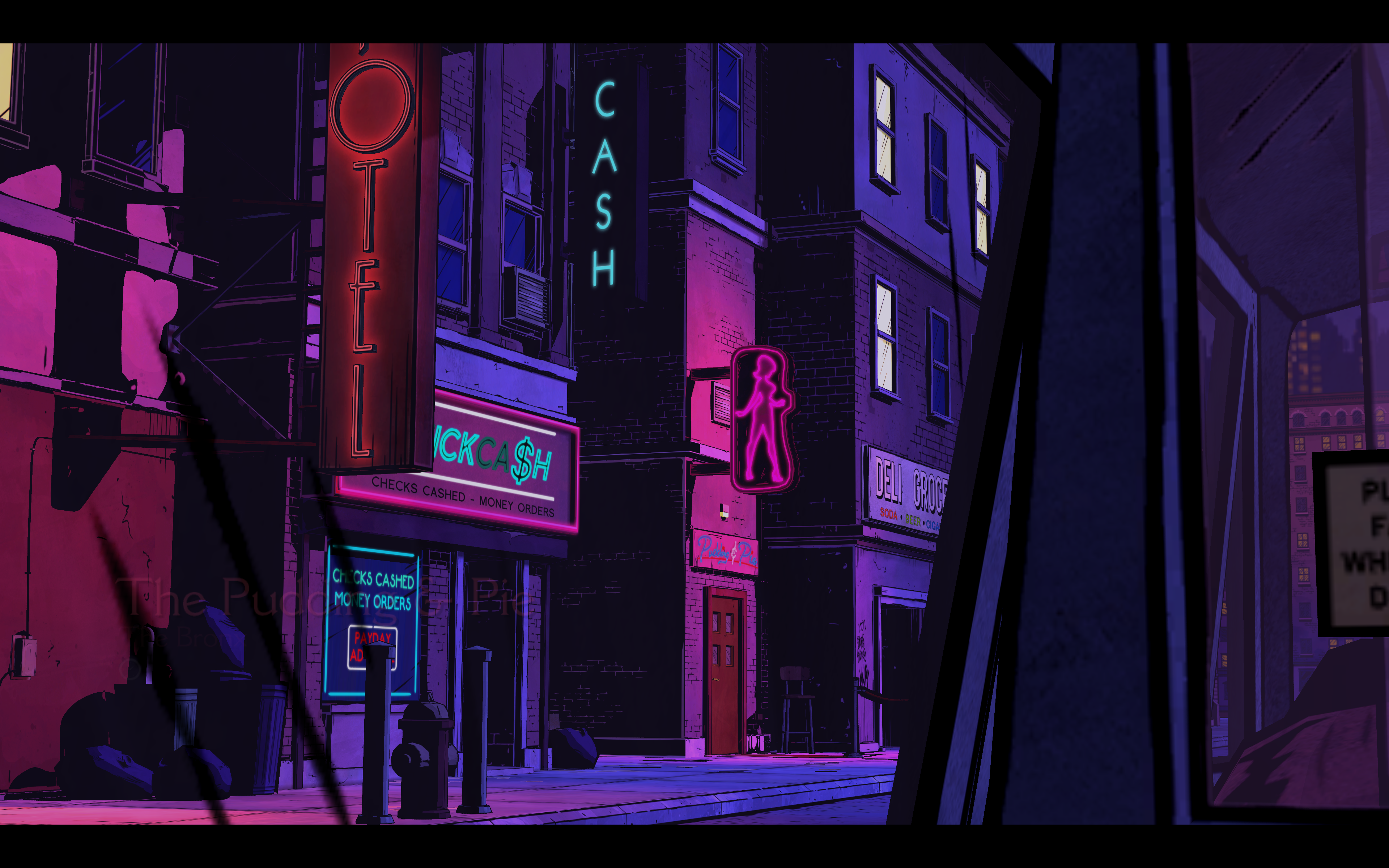
Pixel Boost is our weekly series devoted to the artistry of games, and the techniques required to run them at high resolutions.
Spoiler warning! The gallery grabs screens from most of the episodes, so if you've yet to play The Wolf Among Us we might recommend you, y'know, do that first.
I’m a big fan of the Fables comics series, and I’m not very into comics or talking animals (Homeward Bound is the one exception). They’re creepy. The idea of throwing fairy-tale characters into a grim, real world setting comes off as gimmicky—novel, sure, but not something I’d want to invest years of my life into. And while the series leans heavily on surprising the reader with referential reveals, folktales have persisted for a reason; there’s something universal in them, which is why if given proper development and nuance, the Big Bad Wolf can be a character to care about.
Hi-res how-to
With the Fables comic series at its end after 150 issues, I figured revisiting Telltale’s best-looking game would be a fit farewell to the fabled series. Hey-o!
Luckily, the resolution options were built directly into the game. Just head to the options and pump up the pixels. We ran GeDoSaTo to capture native screenshots, though. If you’d like to do the same, download the program, add “thewolfamongus” to the user whitelist, and assign a screenshot input in under “Edit Keybindings” by deleting the necessary hashes.
The Wolf Among Us is a prequel to the comic series, and carries a decidedly different neon noir tone with it. When a given scene is properly lit and populated, it looks almost directly out of a comic book in 4K. My praise isn’t exactly off-brand here. Neon and harsh lines have always been up my aesthetic alley, so when a scene splits the black with purples and pinks, I’m all in.
The downsampling nearly eliminates every hard edge, giving the colors a much more natural flow, like that of the printed page. The only real downside are the UI elements. QTE prompts look garish and artificial at such a high resolution, almost like clip art. Here's to hoping for a more natural solution in future Telltale games.
I’m not sure I’ll play a Telltale game in anything less than 4K from this point forward.
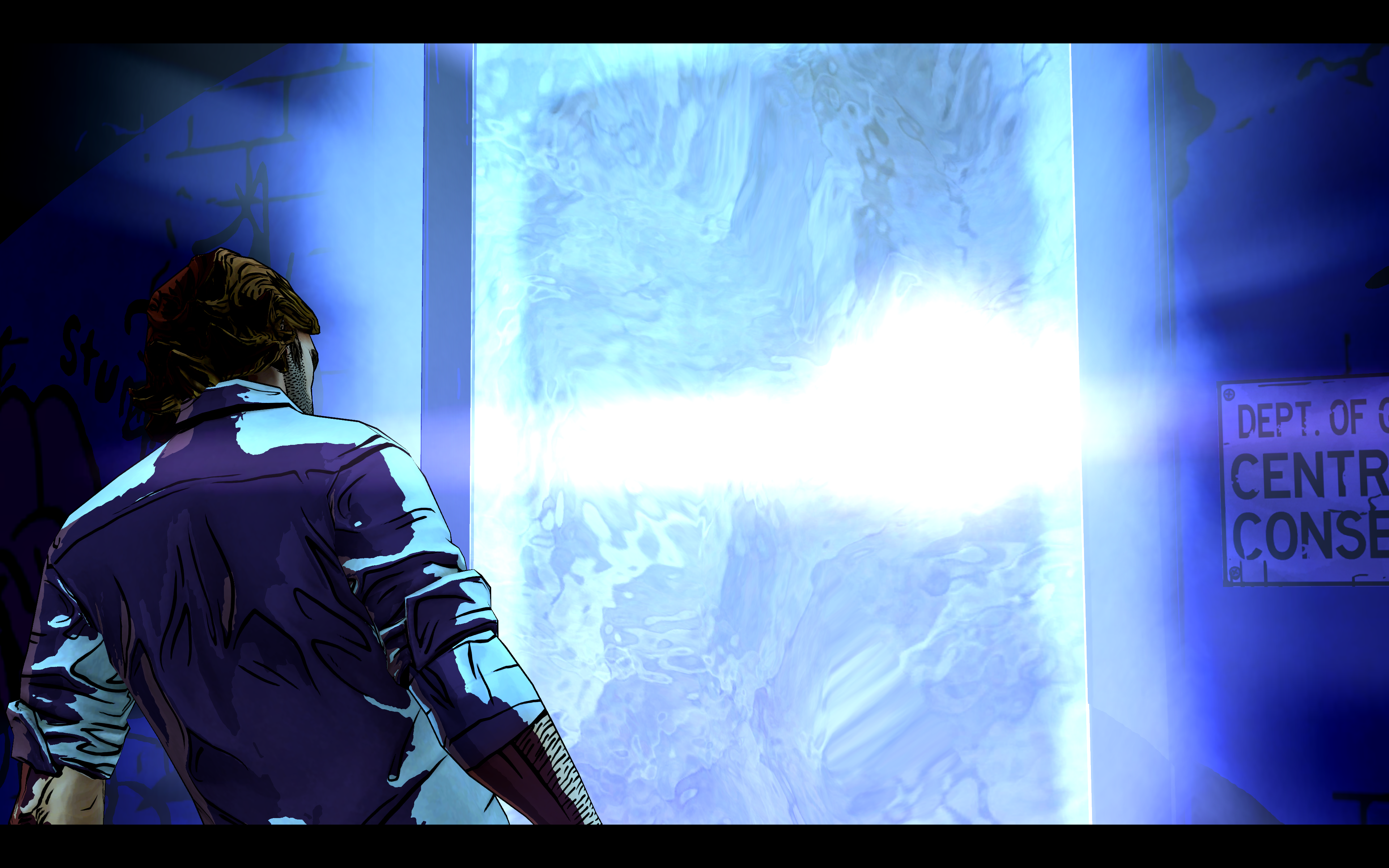
Pixel Boost is our weekly series devoted to the artistry of games, and the techniques required to run them at high resolutions.
Spoiler warning! The gallery grabs screens from most of the episodes, so if you've yet to play The Wolf Among Us we might recommend you, y'know, do that first.
I’m a big fan of the Fables comics series, and I’m not very into comics or talking animals (Homeward Bound is the one exception). They’re creepy. The idea of throwing fairy-tale characters into a grim, real world setting comes off as gimmicky—novel, sure, but not something I’d want to invest years of my life into. And while the series leans heavily on surprising the reader with referential reveals, folktales have persisted for a reason; there’s something universal in them, which is why if given proper development and nuance, the Big Bad Wolf can be a character to care about.
Hi-res how-to
With the Fables comic series at its end after 150 issues, I figured revisiting Telltale’s best-looking game would be a fit farewell to the fabled series. Hey-o!
Luckily, the resolution options were built directly into the game. Just head to the options and pump up the pixels. We ran GeDoSaTo to capture native screenshots, though. If you’d like to do the same, download the program, add “thewolfamongus” to the user whitelist, and assign a screenshot input in under “Edit Keybindings” by deleting the necessary hashes.
The Wolf Among Us is a prequel to the comic series, and carries a decidedly different neon noir tone with it. When a given scene is properly lit and populated, it looks almost directly out of a comic book in 4K. My praise isn’t exactly off-brand here. Neon and harsh lines have always been up my aesthetic alley, so when a scene splits the black with purples and pinks, I’m all in.
The downsampling nearly eliminates every hard edge, giving the colors a much more natural flow, like that of the printed page. The only real downside are the UI elements. QTE prompts look garish and artificial at such a high resolution, almost like clip art. Here's to hoping for a more natural solution in future Telltale games.
I’m not sure I’ll play a Telltale game in anything less than 4K from this point forward.
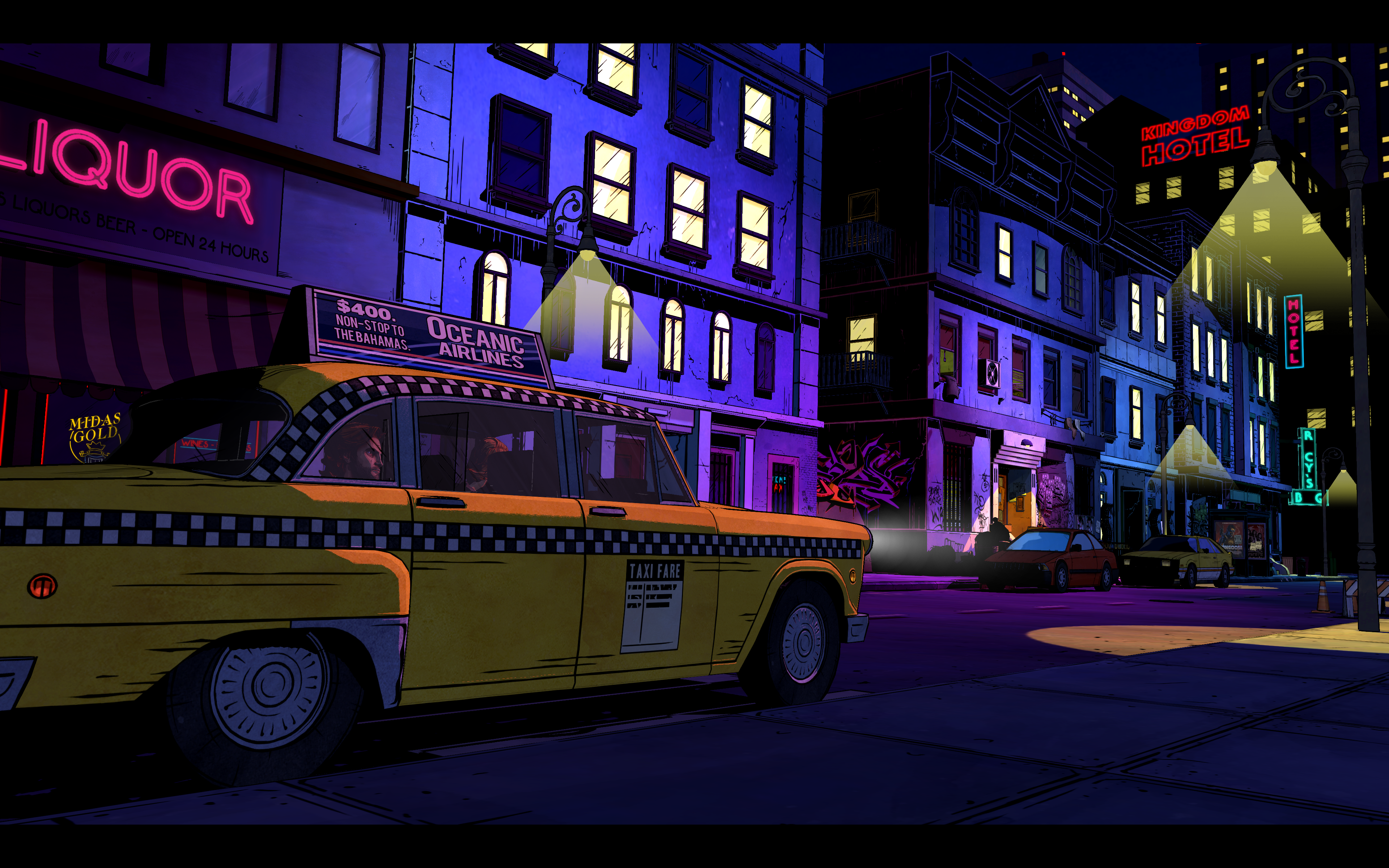
Pixel Boost is our weekly series devoted to the artistry of games, and the techniques required to run them at high resolutions.
Spoiler warning! The gallery grabs screens from most of the episodes, so if you've yet to play The Wolf Among Us we might recommend you, y'know, do that first.
I’m a big fan of the Fables comics series, and I’m not very into comics or talking animals (Homeward Bound is the one exception). They’re creepy. The idea of throwing fairy-tale characters into a grim, real world setting comes off as gimmicky—novel, sure, but not something I’d want to invest years of my life into. And while the series leans heavily on surprising the reader with referential reveals, folktales have persisted for a reason; there’s something universal in them, which is why if given proper development and nuance, the Big Bad Wolf can be a character to care about.
Hi-res how-to
With the Fables comic series at its end after 150 issues, I figured revisiting Telltale’s best-looking game would be a fit farewell to the fabled series. Hey-o!
Luckily, the resolution options were built directly into the game. Just head to the options and pump up the pixels. We ran GeDoSaTo to capture native screenshots, though. If you’d like to do the same, download the program, add “thewolfamongus” to the user whitelist, and assign a screenshot input in under “Edit Keybindings” by deleting the necessary hashes.
The Wolf Among Us is a prequel to the comic series, and carries a decidedly different neon noir tone with it. When a given scene is properly lit and populated, it looks almost directly out of a comic book in 4K. My praise isn’t exactly off-brand here. Neon and harsh lines have always been up my aesthetic alley, so when a scene splits the black with purples and pinks, I’m all in.
The downsampling nearly eliminates every hard edge, giving the colors a much more natural flow, like that of the printed page. The only real downside are the UI elements. QTE prompts look garish and artificial at such a high resolution, almost like clip art. Here's to hoping for a more natural solution in future Telltale games.
I’m not sure I’ll play a Telltale game in anything less than 4K from this point forward.
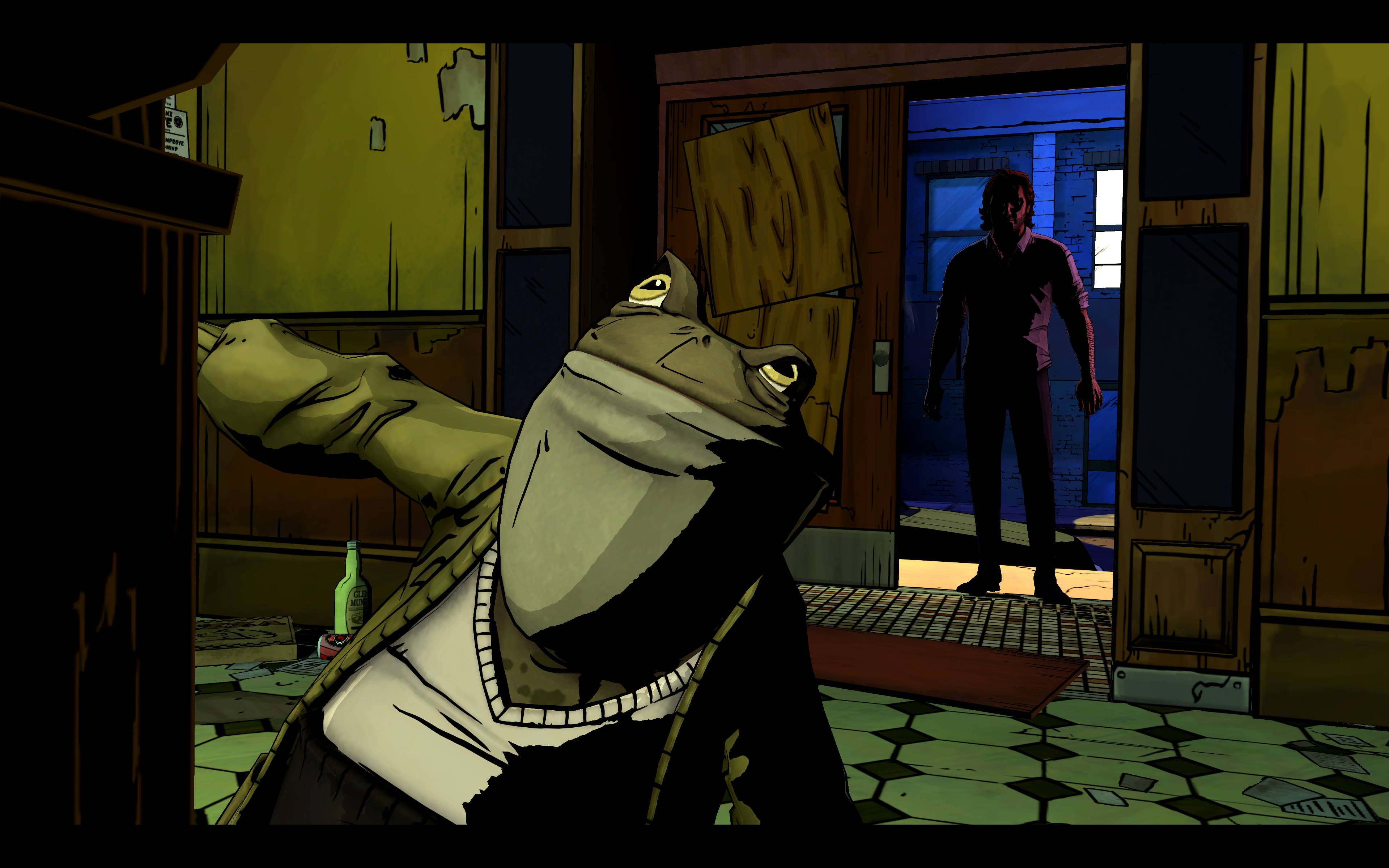
Pixel Boost is our weekly series devoted to the artistry of games, and the techniques required to run them at high resolutions.
Spoiler warning! The gallery grabs screens from most of the episodes, so if you've yet to play The Wolf Among Us we might recommend you, y'know, do that first.
I’m a big fan of the Fables comics series, and I’m not very into comics or talking animals (Homeward Bound is the one exception). They’re creepy. The idea of throwing fairy-tale characters into a grim, real world setting comes off as gimmicky—novel, sure, but not something I’d want to invest years of my life into. And while the series leans heavily on surprising the reader with referential reveals, folktales have persisted for a reason; there’s something universal in them, which is why if given proper development and nuance, the Big Bad Wolf can be a character to care about.
Hi-res how-to
With the Fables comic series at its end after 150 issues, I figured revisiting Telltale’s best-looking game would be a fit farewell to the fabled series. Hey-o!
Luckily, the resolution options were built directly into the game. Just head to the options and pump up the pixels. We ran GeDoSaTo to capture native screenshots, though. If you’d like to do the same, download the program, add “thewolfamongus” to the user whitelist, and assign a screenshot input in under “Edit Keybindings” by deleting the necessary hashes.
The Wolf Among Us is a prequel to the comic series, and carries a decidedly different neon noir tone with it. When a given scene is properly lit and populated, it looks almost directly out of a comic book in 4K. My praise isn’t exactly off-brand here. Neon and harsh lines have always been up my aesthetic alley, so when a scene splits the black with purples and pinks, I’m all in.
The downsampling nearly eliminates every hard edge, giving the colors a much more natural flow, like that of the printed page. The only real downside are the UI elements. QTE prompts look garish and artificial at such a high resolution, almost like clip art. Here's to hoping for a more natural solution in future Telltale games.
I’m not sure I’ll play a Telltale game in anything less than 4K from this point forward.

James is stuck in an endless loop, playing the Dark Souls games on repeat until Elden Ring and Silksong set him free. He's a truffle pig for indie horror and weird FPS games too, seeking out games that actively hurt to play. Otherwise he's wandering Austin, identifying mushrooms and doodling grackles.

